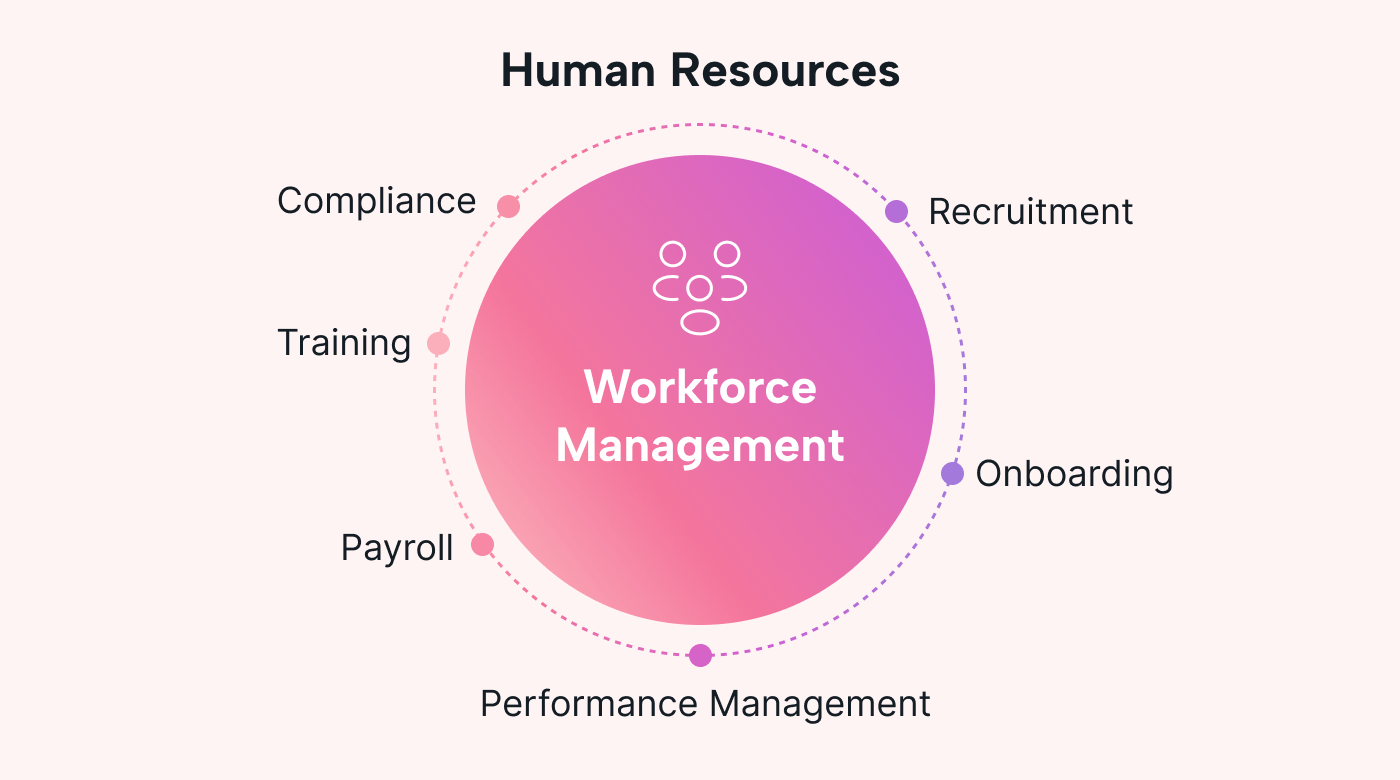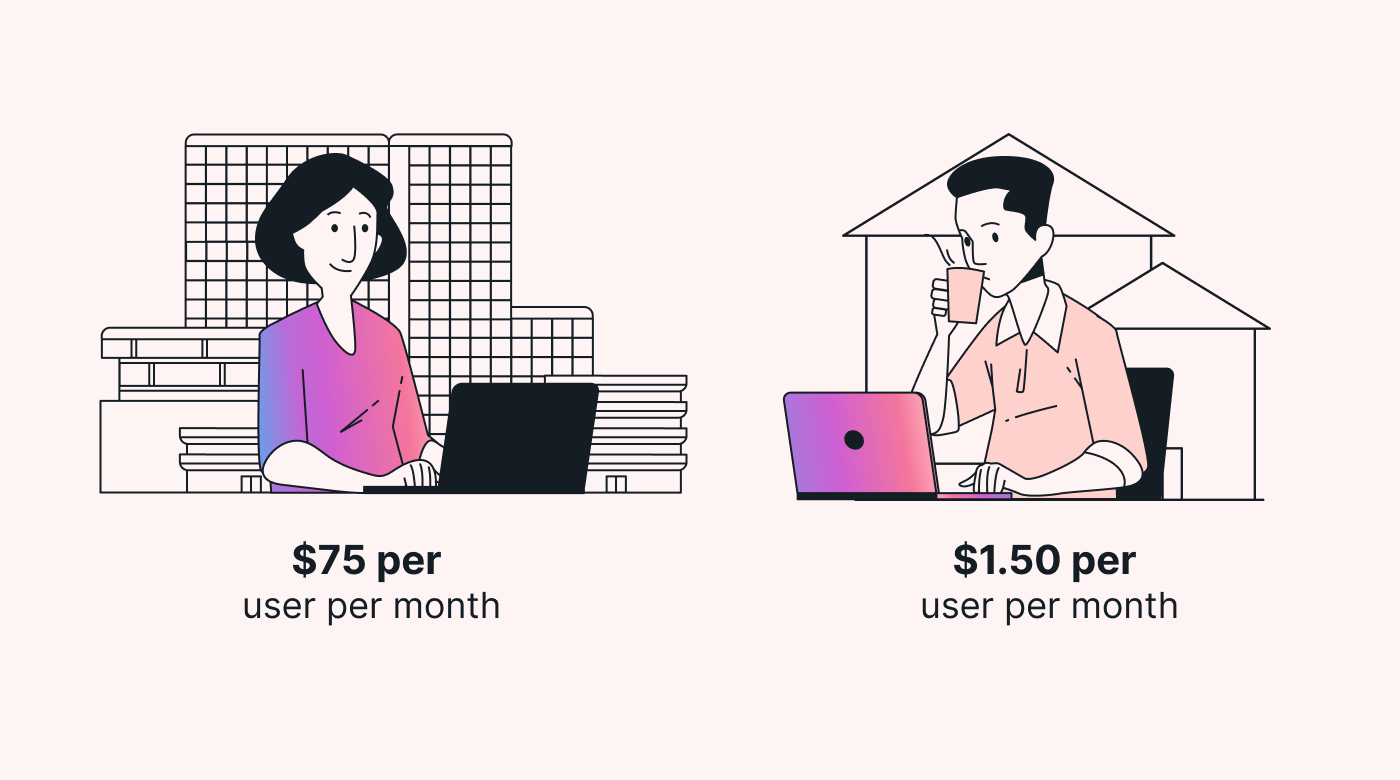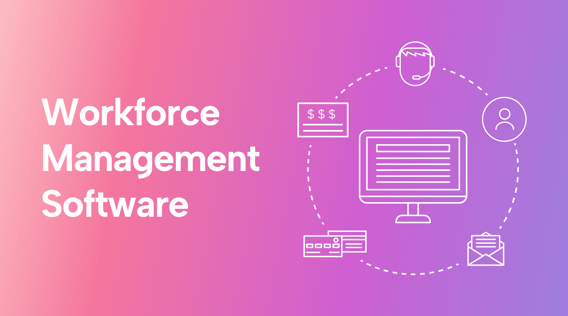Workforce management. It sounds a bit mechanical, like that other term, human resources (HR). As if there are no living, breathing human beings on the other side of those words.
But there are. And if you’re a business owner, these people and their hearts, minds, and passions will be working for you. Your job is to provide them with the right workplace environment and tools to function at their best.
Workforce management software is one of those tools that help your workers make the most out of every day.
In this article, we’ll spell out what workforce management software is and does and how it can benefit your business. We’ll also share 10 software examples that work well for small and mid-sized businesses.
What is workforce management software?
Workforce management software is a set of tools both large and small businesses use to optimize their employees’ productivity and efficiency. Its purpose is to distribute workforce resources effectively so that the company can meet — and, hopefully, exceed — its operational needs.
Workforce management software involves multiple aspects of workforce planning, including but not limited to scheduling, forecasting, and managing staff levels. More on that in a moment.
Here’s an interesting statistic on workforce management software’s rising popularity: the workforce management market was worth $7.5 billion in 2021. That’s already high. But it’s expected to increase to $12.5 billion by 2030!
Is workforce management part of HR?
Yes, workforce management is a part of HR, but it’s not the same as HR.
Here’s the difference: HR encompasses a broad range of functions related to managing people in an organization. Think of the whole spectrum, from recruitment and onboarding to performance management, training and development, and compliance with labor laws.
 |
Workforce management, on the other hand, zeroes in on day-to-day operations. This includes scheduling and calendar management, time and attendance tracking, leave management, and sometimes task or project management.
So think of workforce management as a subset of HR that specifically focuses on the efficient management of the existing workforce.
Larger organizations may have separate departments for HR and workforce management, while in smaller companies, these tasks may all be handled by one HR team or even a single individual.
Why is workforce management software important?
Workforce management can improve your company’s HR management in a variety of ways. Here are six great reasons for investing in workforce management software for your organization:
1. Improved HR efficiency
Workforce management software automates many time-consuming daily tasks, such as employee scheduling, time and attendance tracking, and managing leave requests.
This not only saves time and boosts productivity but also reduces the chance of time-hogging errors that can occur with manual methods.
2. Savings in labor costs
Workforce management can save you not just time but also money.
 |
Accurately tracking employee hours means businesses can reduce overpayments and make sure that all work is properly compensated. This can result in significant operational cost savings over time.
3. Better HR compliance
Compliance with labor laws and regulations can be demanding and complex for your HR staff.
Workforce management software can help businesses meet these requirements more easily. The accuracy the software provides also reduces the risk of costly fines or lawsuits.
4. More employee satisfaction
Employee satisfaction is key to keeping your business running smoothly.
When schedules are clearly communicated and time-off requests are handled in a consistent, fair manner, employees tend to be happier and more engaged.
Plus, there’s the empowerment factor. Many workforce management tools include employee self-service (ESS) portals so that employees can manage their own information, request time off online, and more. With these features, you’ll score another win in employee satisfaction.
5. Better business insights
Most workforce management systems include reporting and analytics functions that can give you valuable insights into your business processes and operations. They provide helpful, real-time insights into the company’s staffing needs, which helps you avoid the unnecessary expense of over- or understaffing at any given time.
6. Scalability for a growing business
As a business grows, workforce management tends to become more complex.
A nice feature of workforce management software is that it’s scalable and can grow with a business — this means you can manage a larger workforce without significantly increasing your administrative workload.
What are the main functions of workforce management software?
Here’s a brief overview of the different functions and automations that workforce management software is generally designed to help you with.
1. Staff scheduling
This feature helps businesses create and manage their employees’ work schedules. A workforce management system can automatically generate schedules based on business rules, employee skills, availability, and other factors, so there’s less need for manual efforts and a smaller potential for human errors.
Some advanced systems even offer real-time adjustments and alerting mechanisms for sudden absences or changes.
By the way, if what you need for your business right now is software that can streamline task allocations, planning, and prioritization, check out Motion’s AI-driven intelligent calendar.
Motion has three main features: tasks, calendars, and a booking system. The app integrates with Google or Microsoft calendars and automatically plans employees’ days based on variables such as deadlines, working hours, task links, and meetings.
With Motion, you can stop worrying about coordinating your team because it always lets you know whether you’re on track.
2. Time and attendance management
Workforce management tools track when employees are working, when they take breaks, and when they arrive at work and leave for the day.
 |
This helps to ensure compliance with labor laws, accurate payroll calculations, and prevention of time theft or misuse.
3. Employee absence management
This function keeps track of employee time off, vacations, leaves, and other absences.
Many workforce management software solutions offer an ESS portal where employees can view and manage their own schedules, request time off, view their timesheets, or even swap shifts with other employees.
4. Task and activity management
Some workforce management software also includes task management capabilities. This involves assigning, tracking, and managing tasks so they’re completed by the right people and on time.
5. Employee performance management
These systems track and analyze data like task completion times and quality, helping managers evaluate individual and team performance. They can also identify trends and provide actionable insights to improve employee productivity and efficiency.
6. Workforce forecasting
This function involves predicting future workforce needs based on historical data. A workforce management software system can predict the volume of business activity in the near future. That means managers can plan accordingly to make sure that the right people with the right skills are available when they’re needed.
7. Compliance
Workforce management systems can help companies maintain compliance with labor laws and regulations. These tools can help with managing overtime and maintaining the necessary documentation for those days when HR audits and tax reporting roll around.
What does workforce management software cost?
Workforce software can be expensive at the enterprise level. But there’s good news for small to medium-sized businesses: low-end platforms can cost as little as $1.50 per user per month.
 |
Even more good news: some of these platforms have free first tiers, so you can try them out to see if they’re a good fit before investing in the software.
10 workforce management software platform examples for small businesses
Now that you have a good sense of what workforce management software can do for your company, let’s review some workforce management platforms that are particularly helpful for startups and small and medium-sized businesses with a limited budget.
This list is not exhaustive by any means, but these examples will give you an idea of what’s out there if your company wants to explore workforce management solutions.
1. Homebase
Homebase’s design caters to hourly teams, which makes employee scheduling and time tracking very straightforward. It’s a popular choice for small businesses because it offers a basic free tier with scheduling and time tracking functionality. Paid plans offer additional key features, like HR and business insights.
Drawbacks: As with similar tiered solutions, businesses that need more advanced HR features or insights will need to upgrade to paid plans or supplement with additional software.
2. BambooHR
While BambooHR is well known for its complete Human Resource Information System (HRIS), it also offers strong workforce management features, such as time tracking tools and scheduling software.
BambooHr also has a user-friendly interface, strong reporting tools, and the ability to handle the employee lifecycle from recruitment to offboarding. This makes it a favorite among small to mid-sized businesses.
Drawbacks: Its pricing can be a bit high for very small businesses.
3. Deputy
This tool is known for its intuitive, easy-to-use, and comprehensive features that include not only scheduling and time tracking but also leave management and tasking.
Drawbacks: Some features, like payroll integration and performance management, are only available in the higher-priced plans, which may be out of range for some small businesses.
4. Zoho People
As part of the Zoho suite of tools, Zoho People brings together many essential features for small businesses, including time and attendance tracking and leave management. It also offers a self-service portal for employees to handle their information and requests.
Drawbacks: While Zoho People covers many basic needs, it lacks some of the more advanced workforce management features more specialized software offers.
5. 7shifts
7shifts is designed specifically for restaurants. It’s excellent for scheduling, time tracking, and team communication.
 |
It also includes labor compliance features and integrates with many Point-of-Sale (POS) systems, which can be very helpful for small businesses in the food service industry.
Drawbacks: It’s less applicable to businesses outside of food service due to its industry-specific design.
6. Gusto
Gusto is particularly well-regarded for its payroll services, but it also includes time tracking and scheduling features.
Gusto is user-friendly and has excellent customer service. Its ability to handle payroll, benefits, and compliance also makes it a practical solution.
Drawbacks: Its cost can be more than some small businesses want to spend on workforce management software. Additionally, while it does offer time tracking and scheduling, these features may be a bit basic compared to dedicated workforce management solutions.
7. When I Work
When I Work is a user-friendly workforce management platform that doesn’t require a steep learning curve. It offers core features like scheduling, time tracking, and team communication.
When I Work is especially well-suited to shift-based small businesses in the retail and hospitality industries. It offers a robust free version for up to 75 users, which makes it ideal for small businesses.
Drawbacks: While it’s great for scheduling and time tracking, it offers limited HR features. This means businesses that need more comprehensive HR tools will have to look elsewhere. Advanced features and full access to integrations require upgrading to the paid plan.
8. Clockify
If you’re looking for straightforward, effective time tracking, then Clockify is worth considering. It has a generous free tier and is easy to use, which makes it a good choice for small businesses that primarily need to track hours worked.
Drawbacks: It has limited features beyond time tracking, so businesses that need comprehensive workforce management or HR features may need to supplement with other software.
9. Paycor
Paycor offers a broad suite of services, including payroll and recruiting, along with workforce management tools, like time and attendance and scheduling. It’s designed to scale with businesses, so it’s a good choice for small businesses with growth ambitions.
Drawbacks: Its interface is not as intuitive or user-friendly as that of some competitors, so there may be a steeper learning curve required. It can also get expensive, particularly for very small businesses.
10. TimeCamp
TimeCamp is primarily a time-tracking software, but it also includes invoicing and billing features. It’s an excellent tool for businesses that bill clients by the hour.
The software also offers productivity analysis, which can be a big plus for small businesses looking to maximize their personnel’s efficiency.
Drawbacks: TimeCamp lacks some of the broader workforce management features. Its interface can also be a bit tricky for new users.
In short, there are many workforce management platforms on the market with a variety of features, so with a little research, you’ll be sure to find something that’s affordable and suits your needs.
Boost your business with workforce management software
Whether you manage a large enterprise, a startup, or a small business, workforce management software can help streamline your workforce operations.
If you’re in the market for this type of software, explore the options in this article to determine which tools would be the best fit for your business needs — and for your unique workforce.
And if you’re looking for an advanced calendar and scheduling tool for your business that’s just as intelligent as the people working for you and will grow with your team, check out Motion’s app. You can try Motion for free with our 7-day trial.





